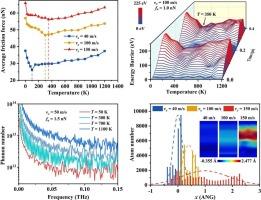解译非单调温度相关滑动摩擦的起源
IF 6.9
2区 材料科学
Q2 CHEMISTRY, PHYSICAL
引用次数: 0
摘要
本文系统地研究了非单调温度依赖性摩擦的起源,该摩擦具有先下降后上升,形成摩擦槽的特点。在低温下,热激发产生少量声子,这有利于尖端越过势垒,从而减少相对势垒和总体摩擦。然而,在高温下,增加的热激发导致更多的声子,导致接触面上的原子碰撞并形成更高的界面势垒,导致更大的摩擦能量耗散。进一步分析表明,随着法向载荷或滑动速度的增加,由于界面原子嵌套程度的增强,摩擦槽的位置向更高的温度移动,这需要在更高的温度下产生更多的声子来帮助尖端越过更大的障碍。本文章由计算机程序翻译,如有差异,请以英文原文为准。


Deciphering origin of nonmonotonic temperature-dependent sliding friction
This article systematically investigates origin of non-monotonic temperature-dependent friction, characterized by initial decrease and then subsequent rise, forming a friction trough. At low temperatures, thermal excitation generates a small number of phonons which facilitate tip crossing over potential barriers and thus reduce relative barriers and overall friction. However, at high temperatures, increased thermal excitation leads to more phonons which causes atoms on contact surfaces to collide and form higher interface barriers, resulting in greater friction energy dissipation. Further analysis shows that as normal load or sliding velocity increases, position of the friction trough shifts towards higher temperatures due to enhanced nesting degree of interface atoms, which requires more phonons generated at higher temperatures for assisting tip crossing over larger barriers.
求助全文
通过发布文献求助,成功后即可免费获取论文全文。
去求助
来源期刊

Applied Surface Science
工程技术-材料科学:膜
CiteScore
12.50
自引率
7.50%
发文量
3393
审稿时长
67 days
期刊介绍:
Applied Surface Science covers topics contributing to a better understanding of surfaces, interfaces, nanostructures and their applications. The journal is concerned with scientific research on the atomic and molecular level of material properties determined with specific surface analytical techniques and/or computational methods, as well as the processing of such structures.
 求助内容:
求助内容: 应助结果提醒方式:
应助结果提醒方式:


